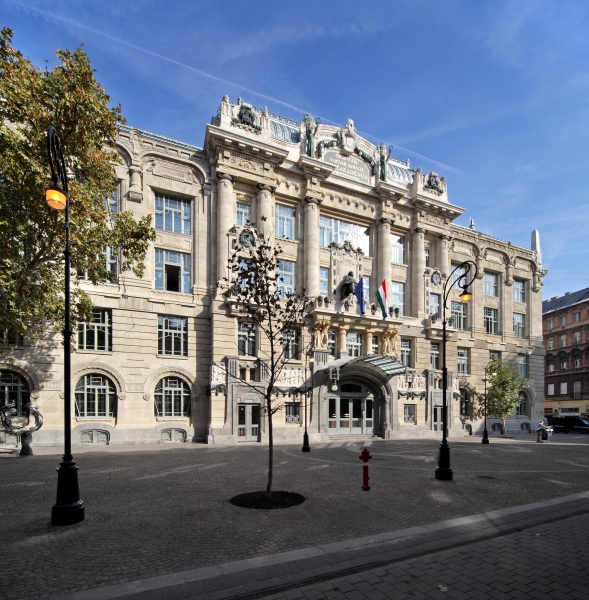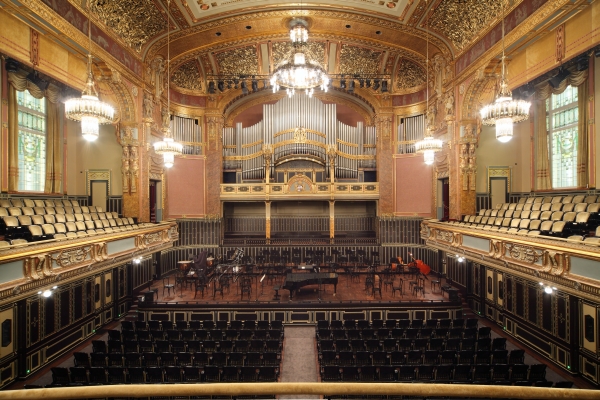Academic Harmony
The Reconstruction of the Music Palace
Architects: Éva Magyari, Béla Pazár, Ferenc Potzner
Text: György Szegő
Photos: József Hajdú

More than a century ago, the foundation of the Music Academy (1875) followed by the construction of the building after designs by Flóris Korb and Kálmán Giergl (1907) was a cause with the potential to create culture, scale beauty and build a community. In the wake of Ferenc Liszt, the high standards of education and concerts established international fame for the Budapest-based Music Academy within a few decades. It is not any different now, when the building was facelifted. Architecture has erected a sacred house to music with the primacy of Art Nouveau style comprising all its genres. Architecture was born here, which means that reconstruction and extension now was an enormous challenge for the team of designers, Magyari–Pazár–Potzner, just like for all associated artists and contractors contributing to the project.
Architecture today is surrounded by a maze of confusing and confused ideas reflecting depreciation. However, I was lucky enough to experience the old-time enthusiasm. 25 years ago, when the reconstruction project was rescheduled by the changes, I could see no hope for the revival of handicraftsmanship. Now it is a genuine holiday that the reconstruction of almost 3000 m² expanse of stone, 6000 m² interior decoration, 400 m² Zsolnay ceramic tiling, almost the same expanse of leaded stained glass, mosaics, ornate fountains, bronze sculptures – based on in-depth studies – was completed in two years by instaurators and the subcontractors’ infrastructure which was recovering after touching the bottom. „Final touches” of restoring the building to its original glory was, however, preceded by static and engineering upgrading, minor extensions in the basement and cupola level, installing the new stage techniques of the Minor Hall, the state-of-art engineering housed on a 25 metre 33 ton steel bridge above the organ. Hoisting in the bridge was a true bravado of engineering and logistics. The epochal success of innovation entailed the success of the latter: it is based on the durability of the first Hungarian R-C frame made by Zielinsky Szilárd who worked in Paris in 1903–05.
The renovation made in a hurry in the 1960s perhaps as a deliberate ideological destruction multiplied the work to be done now as it eliminated the decorative painting, recoloured the opalescent patina of the Main Hall, and slit classrooms to replace the stage loft of the Minor Hall. It was just at the time when the National Theatre was exploded a few blocks away.
Politics back in those days gave the house a rough deal although the institute of the Music Academy and its teachers did indeed legendary work. They created a fantastic piano school: Ferenc Liszt, István Thomán, Árpád Szendy, and then there came the masters who were their apprentices: Béla Bartók, Arnold Székely, Imre Keéri-Szántó, Ernő Dohnányi or Ilona Kabos who were the world-famous talents of music education. Arnold Székely was the master of Annie Fischer, Andor Földes, György Solti, Antal Doráti, and Pál Kadosa who was the master of Dezső Ránki, András Schiff, Zoltán Kocsis, Ferenc Rados and Gergely Bogányi. György Cziffra was a pupil of Keéri-Szántó. The violin school was launched by Jenő Hubay, with students such as Endre Gertler, Stefi Geyer, József Szigeti, Vilmos Tátrai among many others. Then this school of international prestige was carried on by Gyula Mambrinyi, Ede Zathureczky and Imre Waldhauer. The chamber-music school features masters such as Jenő Hubay, Dávid Popper and Leó Weiner. The Roth, Waldbauer-Kerpely, and Weiner string quartets, the Budapest Trió, the Weiner-Szász Chamber Orchestra, Bartók String Quartet, Sándor Végh, Ede Banda, János Starker, Miklós Perényi, András Mihály – and their records – are world-classic brands. The history of music respects Zoltán Kodály and Béla Bartók as pioneers of folk music research, the latter as an avantgarde composer and musician, a classic who integrated Hungarian folk music and modern music. Legendary conductors of the world’s greatest orchestras contributed to the prestige of the Academy: János Richter, Jenő Ormándy, György Széll, Frigyes Reiner, Ferenc Fricsay, Antal Doráti and György Solti. The Minor Hall, which will be inaugurated with the Magic Flute, is going to bear Solti’s name. Opened in 1907, the palace of the Music Academy is a spatial and temporal frame of this list. At that time architecture and its associated arts represented the same world-class standards. At last and primarily I wish to stress the importance of the architects, both of the original project, Flóris Korb and Kálmán Giergl, as well as our contemporary ones.

The Korb-Giergl duo integrated the gem of the Academy into the eclectic fabric of Budapest. And besides, also finding place for Zsolnay ceramics (instaurator: László Czifrák), Alajos Stróbl, the artist of the monumental sculpture portraying Liszt on the façade (instaurator: Szabolcs Csányi), glasses and mosaics by Miksa Róth (instaurators: Miklós Ernő Balázs, Brigitta Mária Kürtösi), the stone reliefs of the façade by Stróbl, Károly Senyei, Ede Telcs, Antal Szabó and Géza Maróti (instaurator: Attila Kovács) or frescos by Aladár Körösfői-Kriesch (instaurator: Izabella Maracskó). Let me hereby emphasize the contribution of art historian Ferenc Dávid, the senior instaurator András Seres and Eszter Fellegi who was in charge of textiles. I am deliberately praising music and visual arts together here. Being the most abstract genres of Gesamtkunstwerk, they compel me to do so.
And now arriving at architecture itself: Korb and Giergl were outstanding architects of a Hauszmann-school comprising a whole generation. They were open to the ideals of Sezession termed as „modern” then, as well as to concepts of the Avantgarde which was then taking shape. (I’ll return to this later.) Following this trend, let us now turn to the team of architects open towards contemporary architectural tendencies: Éva Magyari, Béla Pazár, of whose portfolio I would stress the importance of the Lutheran church in Békásmegyer, Sándor Palace, the reconstruction of the Pauline-Carmelite monastery in Sopronbánfalva, and Ferenc Potzner, who joined this duo. In the case of the latter they brought about a harmonious integrity of reviving tradition and contemporary spirit. Research by Ferenc Dávid facilitated their work.
The history of the institution and the architecture of its building marked out the direction to take. It is logical that they set the goal as „the original status” in the spirit of salvaging values – which is both enormous responsibility and a design challenge in itself. The basement and the cupola has been extended, the couryards built in. An addition to all this is the service technology required by our age, which demanded fresh approach to the details of key importance. Decisions had to be made – such as whether or not to demolish the facework of the Minor Hall, and then restore it to its original. The ebony-imitation inlaid and coloured wall panelling of the Main Hall is also original – only a small part of it has been demolished and rebuilt, after restoring the original components on-site. The backside of the second-storey students’ gallery reveals the cleared restored original surface, elsewhere repainting has not been removed, but the decorative painting was made onto it identical with the original exposed at some parts, beneath which as a first layer there is the original painting. Or, they had to preserve the amazing metal-laurel leaves comprising the air insufflator’s ornamental grilles so that the intensity of air-exchange should not make „whistling” noises. The need of free accessibility had to be tolerated, just like the most modern fire and safety technology (which sadly entails „visual dirt”), and the increased weight of the door providing sound-proofing had to be calculated, just to mention a few challenges.
Perhaps the most sensitive decision had to be made about the large-scale remodelling which was the subject of most debates: it was a truly architectural issue. The skylight courtyards built in now on the sides of the Main Hall received new functions. This is the key of the codes counterpointing the „original restoring” approach and contemporary architecture. And the „contemporary response” proved successful. Designers were just as brave as Korb and Giergl when designing the „boater-capped” cupola roofing. The concrete roof landscape of Korb-Giergl covering the architectonic tradition of the „wall” and „roof” sort of predicts Antonio Sant’Elia’s Futuristic or Hans Hollein’s magical architecture. Preceding forms of building sculptures by André Bloc by 70 years, they relied on the potentials of concrete. Later on it was clad in metal, but the cupola still remains the „timeless” architecture of the house. Designers adjusted the brick cladding of the new atrium to a then fresh gesture and the geometrical tracery of the backside of the windows in the Main Hall, as well as that of the glass surface of the roof, an immaterial lightness kept in plane. How much it is true to Korb and Giergl’s „modernity”, is reflected by the pre-futuristic architecture they designed in 1896 as the pavilion of Urikány-Zsilvölgy Hungarian Coal Mines (see: MÉ 2010/3). This architecture truly proves that the atrium design by Magyari–Pazár–Potzner evokes the spirit of Korb-Giergl. As a sophisticated reference, they cleaned up the quoins of the old windows where even the chipped bricks were discreetly preserved at the ledges – this „concept” is a real hit. We may as well take it as a sign of architectural humour. (Which is necessary, let’s just think of how scarcely accepted the cause of architecture is in Hungary today, which is a fact the designers had to face.)
In the past few decades the Music Academy opened towards Avantgarde and contemporary music, the revolutionary art represented by Péter Eötvös, Zoltán Kocsis, László Sáry, Albert Simon, László Vidovszky László and the experimental new aesthetics of Új Zenei Stúdió, just to name a few. The Academy is thus not a museum, and the palace of music in its revived 2013 format is an authentic contemporary harmony, an old-and-new quality of Hungarian architecture and architectural art.
Design: MNDP Építőművészeti Kft.
Architects: Éva Magyari, Béla Pazár – MNDP Kft., Potzner Ferenc – Közti Zrt.
Fellow architects: György Polyák, Tibor Bodnár, Gergő Demjén, Gergő Jászai, Gergő Székely, Dani Mecseki – MNDP Kft., Garai Péter – Közti Zrt.
Soil mechanics, hydrology: József Farkas, Miklós Armuth – BME
Expert on statics: Dr. Miklós Armuth, Dr. György Visnovitz BME
Documentation: Ferenc Bor – Hild-Ybl Alapítvány
Art historian: Ferenc Dávid
Structure: Péter Váczi – Közti Zrt.
HVAC: András Oltvai, Tamás Oltvai – ART-TAX Szövetkezet, Oltvai Gépész Stúdió
Acoustics: Éva Arató, Larry Kirkergaard – Arató Akusztika Kft.
Main contractor: Arcadom-Laki-Swietelsky Konzorcium, ZAK Kft.
Project management: Tamás Kiss Vámosi













